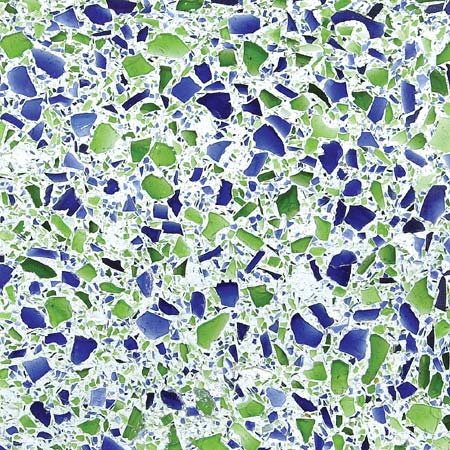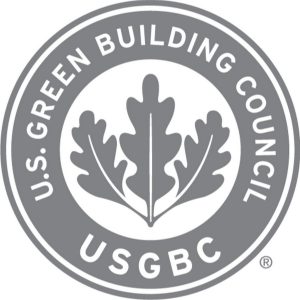The Environmental Impact of the Use of Cement and Epoxy Terrazzo
History
 Terrazzo flooring has a long and rich history that dates back over 1500 years. Terrazzo, from the Italian word for terraces, is one of the original recycled products – created centuries ago by Venetian workers utilizing the waste chips from slab marble processing. Today terrazzo flooring continues to provide the ultimate in durability and low maintenance, typically lasting the life of the building. The combination of beauty, durability, and low maintenance has led to a renaissance in the use of terrazzo over the past decade. The demand for terrazzo is increasing in many markets, from performance driven institutions such as schools, airports, and hospitals, to the designer driven markets of retail and commercial buildings. Terrazzo is the ultimate choice when evaluating finishes on a life cycle basis.
Terrazzo flooring has a long and rich history that dates back over 1500 years. Terrazzo, from the Italian word for terraces, is one of the original recycled products – created centuries ago by Venetian workers utilizing the waste chips from slab marble processing. Today terrazzo flooring continues to provide the ultimate in durability and low maintenance, typically lasting the life of the building. The combination of beauty, durability, and low maintenance has led to a renaissance in the use of terrazzo over the past decade. The demand for terrazzo is increasing in many markets, from performance driven institutions such as schools, airports, and hospitals, to the designer driven markets of retail and commercial buildings. Terrazzo is the ultimate choice when evaluating finishes on a life cycle basis.
In recent years the construction industry has begun to focus on the environmental impact of many construction materials. The evaluation of products in the “green movement” encompasses many elements, which must be weighed on a scale of relative importance. These elements include the longevity of the material, the composition, maintenance, recycled contents, embodied energy, and the “cradle-to-grave” environmental impact.
Durability
Sustainable construction is at the core of green construction. Terrazzo floors have an outstanding record of durability and performance dating back over a thousand years. The floors will typically last the life of the structure. In many older buildings, the floors can be restored to their original luster at a fraction of the cost of replacing the finish.
Both cement and thin set epoxy terrazzo floors have extremely low maintenance costs. Annual stripping and resealing can utilize environmentally friendly water-based products. Routine maintenance includes dry and damp mopping, with an occasional spray buffing. In comparison, carpet requires energy intensive daily vacuuming and periodic steam cleaning.
Composition and Embodied Energy
 Terrazzo is composed of naturally occurring aggregates, recycled glass or plastic and processed cement or epoxy binders. The binders constitute approximately 25 to 30 percent of the volume of the terrazzo floors; the remainder of the floor is composed of aggregates, pigments, and fillers. Initial life cycle assessments of embodied energy appear extremely favorable due to the longevity and low energy usage for maintenance.
Terrazzo is composed of naturally occurring aggregates, recycled glass or plastic and processed cement or epoxy binders. The binders constitute approximately 25 to 30 percent of the volume of the terrazzo floors; the remainder of the floor is composed of aggregates, pigments, and fillers. Initial life cycle assessments of embodied energy appear extremely favorable due to the longevity and low energy usage for maintenance.
Recycle/Reuse Content
Aggregates used in terrazzo are the most common sources of recycled content. Several glass aggregate suppliers are currently providing post-consumer recycled glass to the marketplace. Several slab marble and granite quarries have supplies of post-industrial stone left from slab granite and marble processing. The plastic chips may contain as much as twenty percent recycled plastic. Aluminum divider strips may also incorporate recycled metal. If an underbed is utilized, the steel reinforcing will have recycled content. Cement used in cementitious terrazzo may also have recycled content.
VOC Off-Gassing and Indoor Air Quality
Both cement based and thin set epoxy terrazzo systems are comprised of zero VOC materials. Terrazzo exhibits little or no off-gassing over the life of the cured floor. The non-porous, cleanable terrazzo finish does not support microbial growth, nor allow moisture to accumulate, helping to maintain a mold-free environment with improved indoor air quality.
Regional Sourcing
The United States terrazzo industry consists of many manufacturers, suppliers, and distributors strategically located throughout the country. Terrazzo is manufactured on-site minimizing post-commercial waste and transportation costs. By comparison, much of the marble and ceramic floor tile used in the United States is manufactured overseas and imported. Cement and sand used in cementitious terrazzo may be regionally sourced. Depending on the mix, aggregates may also have regional sources.
 U.S. Green Building Council “LEED® Green Building Rating System”
U.S. Green Building Council “LEED® Green Building Rating System”
Terrazzo has long been valued for its life cycle characteristics: low maintenance, durability, and indoor air quality – with recycled content being an additional attractive feature. Terrazzo flooring can contribute to the achievement of project LEED certification goals. The project LEED Consultant will identify which credits are included in the project sustainability goals.
LEED® Credit Information and Point Chart
MRc1.2 “Building Reuse—Maintain Interior Nonstructural Elements”
Points may be awarded be re-using a portion of existing non-structural elements, including floors. Terrazzo floors typically last the life of the structure. As such, in many renovation projects, the original terrazzo flooring can be restored to its original luster following some inexpensive repairs and refinishing. The ability to preserve the floor intact rather than replacing it will cut costs and contribute towards this LEED® credit.
MRc2 “Construction Waste Management”
Points may be awarded by recycling or salvaging nonhazardous construction and demolition debris. In projects that require demolition of an existing structure with terrazzo flooring, terrazzo components may be salvaged for reuse or recycled. A qualified terrazzo contractor can assist with component recovery. If terrazzo flooring is to be used in the new construction, the salvaged aggregate can even potentially be used in the new flooring.
MRc4 “Recycled Content”
Points may be awarded for using materials with recycled content. Terrazzo allows for easy incorporation of recycled glass, as well as stone or marble that has been salvaged from other buildings and re-crushed and sieved for use in terrazzo. A floor incorporating 100 percent recycled glass aggregate could contain as much as 75 percent recycled raw material by volume. Aluminum strips may also contain recycled metal.
MRc5 “Regional Materials”
Points may be awarded if a portion of the project building materials are extracted, harvested or recovered, as well as manufactured within a 500-mile radius of the project. The calculation is based on the cost of raw materials. Marble chips, glass aggregate, as well as cement and epoxy binders are available throughout many areas of the United States. Terrazzo can contribute to points if raw material suppliers are located within 500 miles of the project site.
IEQc4.1 “Low Emitting Materials—Adhesives and Sealants”
Points may be awarded if the terrazzo installation does not include adhesives and sealants that contain Volatile Organic Compounds (VOCs) in excess of certain limits. Cement based terrazzo systems use inorganic binders that contain no VOCs. The manufacturers of thin set epoxy terrazzo systems have moved to 100 percent solid formulas, eliminating the addition of any VOCs in the material. Certification of compliance may be obtained from the individual epoxy manufacturer.
IEQc4.3 “Low-Emitting Materials – Flooring Systems”
Points may be awarded if terrazzo sealers do not contain VOCs in excess of certain limits. Sealers used in finishing terrazzo will generally comply. For schools, flooring elements must meet testing and product requirements of the California Department of Health Services Standard Practice for the Testing of Volatile Organic Emissions from Various Sources Using Small-Scale Environmental Chambers, including 2004 Addenda. Generally, epoxy terrazzo products will comply.
IDc1 “Innovation in Design”
Additional points may be awarded under the Innovation inDesign category for innovative performance in categories not specifically addressed by LEED or for achieving exemplary performance in an established LEED credit.
The following chart is a representation of the four LEED programs
- LEED 2009 for New Construction and Major Renovations
- LEED 2009 for Schools New Construction and Major Renovations
- LEED 2009 for Core and Shell Development
- LEED 2009 for Commercial Interiors and the possible points available
| New Construction & Major Renovations | Schools | Core & Shell | Commercial Interiors | |
|---|---|---|---|---|
| MRc1.2 “Building Reuse—Maintain Interior Nonstructural Elemen ts” | 1–3 points | 1–2 points | 1–5 points | 1–2 points |
| MRc2 “Construction Waste Management” | 1–2 points | 1–2 points | 1–2 points | 1–2 points |
| MRc4 “Recycled Content” | 1–3 points | 1–3 points | 1–3 points | 1–2 points |
| MRc5 “Regional Materials” | 1–2 points | 1–2 points | 1–2 points | 1–2 points |
| IEQc4.1 “Low-Emitting Materials—Adhesives and Sealants” | 1 point | 1 point | 1 point | 1 point |
| IEQc4.3 “Low-Emitting Materials – Flooring Systems | 1 point | 1 point | 1 point | 1 point |
| IDc1 “Innovation in Design” | 1–5 points | 1–4 points | 1–5 points | 1–5 points |
